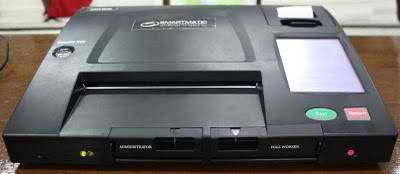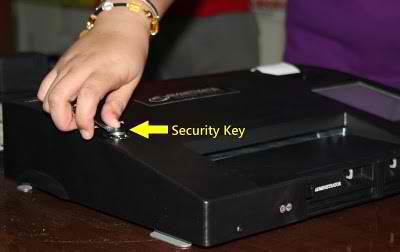In line with the upcoming Senatorial election, we decided to give you
a short preview of the controversial automated tool that will be used
to count our vote –the Precinct Count Optical Scan machine or commonly
known as PCOS machine.
Background
The first time that our country embarked on an electronic automated election was during the ARMM general election in 2008. This served as a dry-run for the then upcoming Presidential election which took place two years after.

In the first automated election, the Commission of Election used two different machines to count votes; Smartmatic-Sahi DRE (Direct Recording Electronic) voting machine and AITI’s (AVANTE International Technology, Inc.) Optical Mark Reader. The former uses a touchscreen display which allows voters to just press an area of the screen to cast their vote and is designed to cater to PWDs and illiterate voters.
AITI’s OMR, on the other hand, requires the use of a ballot to which it will read a vote from. This is similar to Smartmatic’s PCOS machine which was used during the 2010 Presidential election.
Setting up the PCOS machine
In the most basic sense, a PCOS machine works similarly to a machine used in local sweepstakes betting stations. It’ll only read shaded portions of a specially-tailored paper, records the information and then transmit to a server that pools/counts it.
Of course, it’s not as simple as the one used by PCSO (Philippine Charity Sweepstakes Office) for the lottery. Smartmatic’s PCOS machine is equipped with several features that limit the possibility of tainting the integrity of the election result. Let’s start with powering the machine.

Turning on the machine alone requires a three-step verification process which involves inserting a Security Key (as seen in the image above), and typing two different passwords that are given to two different voting officials. If one enters a wrong password or in the event that 1 of the 3 security features of the machine are not setup properly, the machine will not startup. The same process is required if changes have to be done in the machine’s configuration and when turning off the machine.
Voting process
Preferably, each able voter should be given a blank ballot upon entering the venue. Reason why we said preferably is because a known electoral fraud involves giving a voter a pre-filled ballot. Anyway, let’s just assume that we’re living in a perfect world with 0% of election-related anomalies, shall we?
A voter then needs to shade a blank portion that corresponds to their desired candidate. Once done, the voter needs to insert the ballot in to the machine. The machine then will give a confirmation about the validity of the ballot which will be displayed on the machine’s LCD screen.

If everything goes accordingly, the machine will save the information on two different CF(Compact Flash) cards. The second card will serve as a backup storage in the event that the first one fails. At the end of the polling day, a paper similar to a receipt is then printed out by the PCOS machine’s built-in printer. This will display the total number of ballots in the vault and the results. These information are then counter-checked based on the digits projected on the machines LCD screen.
Validation and Transmission
Once the information validated, the voting official will then initiate the transmission of the data stored in the CF cards. It will be transmitted to three different servers; to an accredited political party, to the media and to COMELEC.
The transmission can be done in two way; Wired and Wirelessly. In urban areas where network signals are abundant, the information are transmitted through the use of provisioned SIM card which is similar to sending SMS.

On the other hand, in rural areas where signal is weak, the data is passed on to a device called BGAN or Broadband Global Area Network through a LAN connection between the PCOS machine and BGAN. The good thing about the BGAN device is that it doesn’t rely on a telco’s cell site to transmit the data to the three servers. Instead, it utilizes stationery satellites that are capable of transmitting information from anywhere in the world.
In the past, it will take 2-3 months before the voting result is finalized, but through the help of this PCOS machines, the turnaround time is reduced down to two to three days.
Additional Features
Because of the magnitude and complexity of a national election, the manufacturer includes additional feature to the machine that lessens the possibility of an electoral fraud. Below are some of the additional features of the PCOS machines:
• PCOS machines are equipped with a battery that is rated to last for 12-16 hours. This acts as preventive measure in the event of a power outage in the election day.
• On top of the battery, COMELEC also provides power generator to keep the machine running in case the built-in battery is drained.
• The CF cards used in a PCOS machine are sealed.
• Data stored in the CF cards has a 256-bit encryption.
• If the two stated mode of transmission failed, a certified PCOS technician can personally bring the CF cards to the municipal servers.
Conclusion
While we don’t share COMELEC’s confidence with the PCOS machines (esp. after seeing numerous failed mock elections), we have to admit that the department has exerted a commendable amount of effort to ensure that the machines will function as it should.
In my opinion, we cannot totally eliminate the flaws from the machine, after all there will still be human intervention involve in operating it. My main concern in the upcoming election has actually little to do with the machine, but with the mindset that the voters have in keeping the sanctity of their votes.
At the end of the day, if there are still voters who would whole-heartedly sell their votes to crappy politicians, a PCOS machine in tip-top shape won’t do us and our country any good.
Background
The first time that our country embarked on an electronic automated election was during the ARMM general election in 2008. This served as a dry-run for the then upcoming Presidential election which took place two years after.

In the first automated election, the Commission of Election used two different machines to count votes; Smartmatic-Sahi DRE (Direct Recording Electronic) voting machine and AITI’s (AVANTE International Technology, Inc.) Optical Mark Reader. The former uses a touchscreen display which allows voters to just press an area of the screen to cast their vote and is designed to cater to PWDs and illiterate voters.
AITI’s OMR, on the other hand, requires the use of a ballot to which it will read a vote from. This is similar to Smartmatic’s PCOS machine which was used during the 2010 Presidential election.
Setting up the PCOS machine
In the most basic sense, a PCOS machine works similarly to a machine used in local sweepstakes betting stations. It’ll only read shaded portions of a specially-tailored paper, records the information and then transmit to a server that pools/counts it.
Of course, it’s not as simple as the one used by PCSO (Philippine Charity Sweepstakes Office) for the lottery. Smartmatic’s PCOS machine is equipped with several features that limit the possibility of tainting the integrity of the election result. Let’s start with powering the machine.

Turning on the machine alone requires a three-step verification process which involves inserting a Security Key (as seen in the image above), and typing two different passwords that are given to two different voting officials. If one enters a wrong password or in the event that 1 of the 3 security features of the machine are not setup properly, the machine will not startup. The same process is required if changes have to be done in the machine’s configuration and when turning off the machine.
Voting process
Preferably, each able voter should be given a blank ballot upon entering the venue. Reason why we said preferably is because a known electoral fraud involves giving a voter a pre-filled ballot. Anyway, let’s just assume that we’re living in a perfect world with 0% of election-related anomalies, shall we?
A voter then needs to shade a blank portion that corresponds to their desired candidate. Once done, the voter needs to insert the ballot in to the machine. The machine then will give a confirmation about the validity of the ballot which will be displayed on the machine’s LCD screen.

If everything goes accordingly, the machine will save the information on two different CF(Compact Flash) cards. The second card will serve as a backup storage in the event that the first one fails. At the end of the polling day, a paper similar to a receipt is then printed out by the PCOS machine’s built-in printer. This will display the total number of ballots in the vault and the results. These information are then counter-checked based on the digits projected on the machines LCD screen.
Validation and Transmission
Once the information validated, the voting official will then initiate the transmission of the data stored in the CF cards. It will be transmitted to three different servers; to an accredited political party, to the media and to COMELEC.
The transmission can be done in two way; Wired and Wirelessly. In urban areas where network signals are abundant, the information are transmitted through the use of provisioned SIM card which is similar to sending SMS.

On the other hand, in rural areas where signal is weak, the data is passed on to a device called BGAN or Broadband Global Area Network through a LAN connection between the PCOS machine and BGAN. The good thing about the BGAN device is that it doesn’t rely on a telco’s cell site to transmit the data to the three servers. Instead, it utilizes stationery satellites that are capable of transmitting information from anywhere in the world.
In the past, it will take 2-3 months before the voting result is finalized, but through the help of this PCOS machines, the turnaround time is reduced down to two to three days.
Additional Features
Because of the magnitude and complexity of a national election, the manufacturer includes additional feature to the machine that lessens the possibility of an electoral fraud. Below are some of the additional features of the PCOS machines:
• PCOS machines are equipped with a battery that is rated to last for 12-16 hours. This acts as preventive measure in the event of a power outage in the election day.
• On top of the battery, COMELEC also provides power generator to keep the machine running in case the built-in battery is drained.
• The CF cards used in a PCOS machine are sealed.
• Data stored in the CF cards has a 256-bit encryption.
• If the two stated mode of transmission failed, a certified PCOS technician can personally bring the CF cards to the municipal servers.
Conclusion
While we don’t share COMELEC’s confidence with the PCOS machines (esp. after seeing numerous failed mock elections), we have to admit that the department has exerted a commendable amount of effort to ensure that the machines will function as it should.
In my opinion, we cannot totally eliminate the flaws from the machine, after all there will still be human intervention involve in operating it. My main concern in the upcoming election has actually little to do with the machine, but with the mindset that the voters have in keeping the sanctity of their votes.
At the end of the day, if there are still voters who would whole-heartedly sell their votes to crappy politicians, a PCOS machine in tip-top shape won’t do us and our country any good.